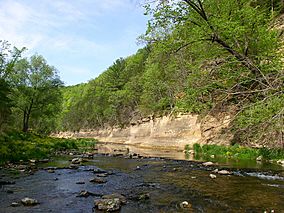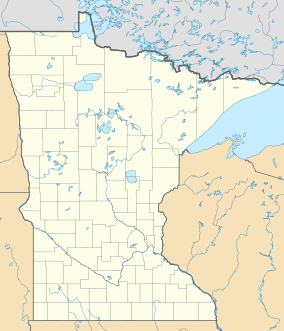Whitewater State Park facts for kids
Quick facts for kids Whitewater State Park |
|
|---|---|

The Whitewater River in Whitewater State Park
|
|
| Location | Winona, Minnesota, United States |
| Area | 1,672 acres (6.77 km2) |
| Elevation | 899 ft (274 m) |
| Established | 1919 |
| Governing body | Minnesota Department of Natural Resources |
|
Whitewater State Park CCC/WPA/Rustic Style Historic Resources
|
|

Sign at the south entrance to the park
|
|
| Location | Off Minnesota State Highway 74, Elba Township, Minnesota |
|---|---|
| Area | 563 acres (228 ha) |
| Built | 1934–41 |
| Architect | National Park Service, Civilian Conservation Corps, Works Progress Administration |
| Architectural style | National Park Service rustic |
| MPS | Minnesota State Park CCC/WPA/Rustic Style MPS |
| NRHP reference No. | 89001661 |
| Added to NRHP | October 25, 1989 |
Whitewater State Park is a beautiful state park in Minnesota, United States. It protects a part of the Whitewater River and is surrounded by tall, rocky bluffs. You can find it in Winona County, in the southeastern part of the state known as the Driftless Area.
This park covers about 2,700-acre (11 km2) of land. It's famous for its amazing views and for trout fishing in the river and Trout Run Creek, which are fed by natural springs. Around 300,000 people visit the park every year. It's located about 7 miles (11 km) north of St. Charles on Minnesota State Highway 74, which goes right through the park.
Contents
Park History and Buildings
The buildings and structures in Whitewater State Park were built in the 1930s. They are so special that they are listed on the National Register of Historic Places. This means they are important historical sites!
Building with Help: CCC and WPA
Many of these buildings were created by workers from programs like the Civilian Conservation Corps (CCC) and the Works Progress Administration (WPA)]. These were government programs during the Great Depression that helped people find jobs. They built many parks and public spaces across the country. The buildings here show a special style called "National Park Service rustic," which uses natural materials to blend in with the environment.
Amazing Landforms and Geology
The ground in the park is made up of old sedimentary rocks, mostly limestone and dolomite. The Whitewater River has carved deep valleys into these rocks over many years. This area is known for its karst topography, which means it has features like sinkholes and caves formed by water dissolving the rock.
Plants and Animals
Whitewater State Park is a special place where two different types of natural areas meet: the Rochester Plateau Subsection and the Blufflands Subsection. Both of these are part of a larger area called the Paleozoic Plateau section of the Eastern Broadleaf Forest Province. This mix of environments means you can find a wide variety of plants and animals living here.
The 2007 Flood Event
On August 18 and 19, 2007, a big flood caused a lot of damage to the park. This area is part of the Driftless Area, where the soil is thin and doesn't hold water very well. The ground is also made of porous rock, which means water can quickly drain into the ground.
How the Flood Happened
The park has steep hills, bluffs, and deep valleys called coulees. These features make streams flow very fast and cause a lot of erosion. When the heavy rains came, the ground couldn't soak up all the water. This led to flash floods that quickly overflowed the river and spread across the valley floors.
Damage and Recovery
About 500 campers were staying in the park when the flood hit. Three bridges were destroyed, and many other parts of the park were badly damaged. This included campgrounds, bathhouses, a dining hall, and the water and sewer systems. The damage cost more than four million dollars.
The park had to close on August 20, 2007, and stayed closed for the rest of the year. It started to reopen slowly on March 1, 2008, but it took a long time for all the damaged areas to be fixed.




